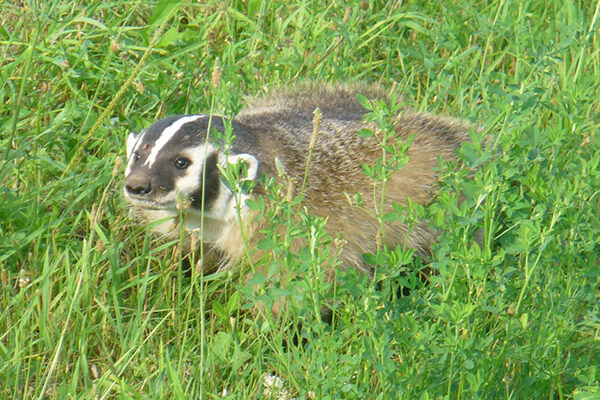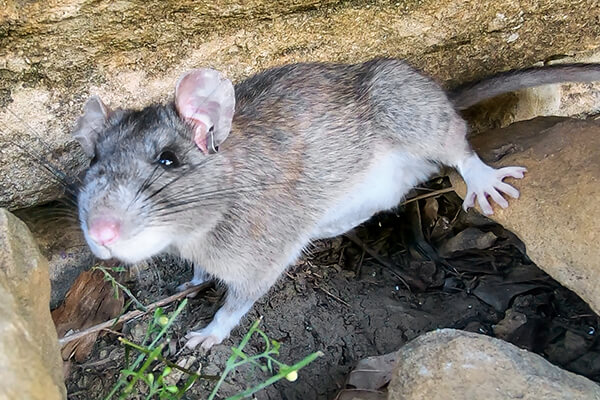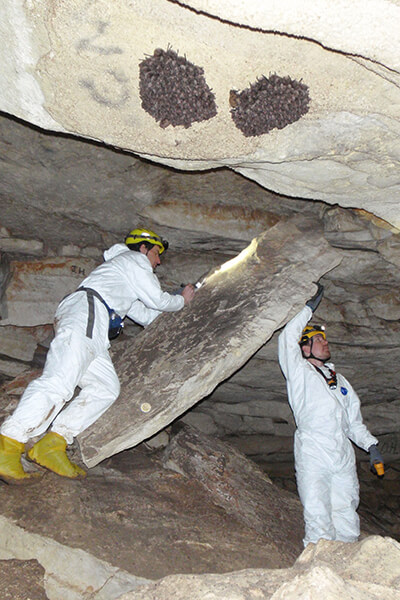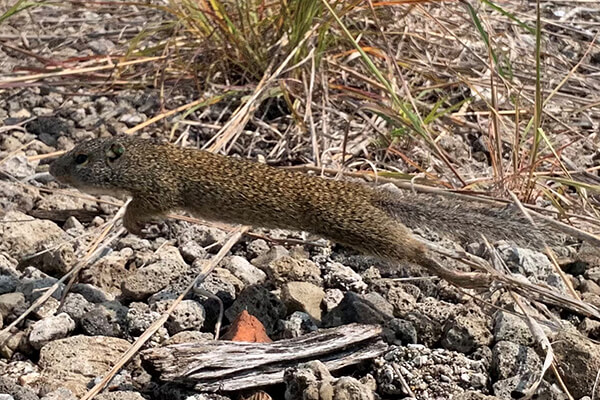Select image to enlarge and view caption.
From the sky to underground, Indiana’s 60 species of mammals occupy diverse habitats in the state including forests, prairies, caves, cliffs, dunes, wetlands, lakes, and rivers. Some species may be seen near developed areas such as cities, suburbia, and agricultural lands. Many, however, may go unnoticed because of their nocturnal and secretive lifestyles, particularly the 13 species of bats, flying squirrels, and armadillos. Others, such as Allegheny woodrat and Franklin’s ground squirrel, occupy unique or rare habitats, making them difficult for most Hoosiers to see. In contrast, other interesting species such as star-nosed mole and thirteen-lined ground squirrel may be found in parks or backyards.
Of Indiana’s 60 mammal species, 22 are listed as a Species of Greatest Conservation Need (SGCN) by the Indiana DNR. Check out the list of Indiana’s mammals below and explore the links on this page to learn more about Indiana’s unique, rare, and exciting mammals.
Habitat management and conservation programs for these species are supported through the generosity of Hoosiers who donate to the Indiana Nongame Wildlife Fund. No state tax dollars are used to manage these species. Consider donating today.
Monitoring Mammal Populations
Indiana DNR mammalogists conduct monitoring and research to better understand the status and distribution of the state’s mammals and to inform management activities. Several species have been monitored since the early 1980s, providing valuable long-term information.
- Winter Bat Counts
Winter surveys of hibernating bats have been an important part of this program for nearly 40 years. This long-term information has enabled the Indiana DNR to employ management strategies to benefit winter bat populations. Notable increases in the number of hibernating bats occurred in the mid-1980s and 1990s after cave tours were discontinued and bat-friendly gates were installed at cave entrances to prevent unlawful access. Populations declined sharply after the detection of white-nose syndrome (WNS) in 2011, but they appear to have begun the long road to recovery.
- Acoustic Monitoring of Summer Bat Populations
Since 2011, Indiana DNR has used ultrasonic detectors and microphones to record the echolocation calls emitted by free-flying bats in the environment. This information has validated what was observed in the hibernation caves, that bat numbers were declining, likely due to white-nose syndrome (WNS). Echolocation calls from 2016 to 2019 suggest that each bat species affected by WNS had survived the novel wave of the disease and numbers were slowly rebounding.
Since 2020, Indiana has adopted methods of the North American Bat Monitoring Program (NABat), thereby contributing acoustic information to monitor bat populations across species’ entire geographic ranges. See an overview of the locations and results of DNR staff surveys for bats.
- Monitoring Summer Bat Roosts
Since 2015, Indiana DNR has been monitoring summer bat roosts on private property to assess areas where roosts are likely to occur, structures they might occur in, and the growth of each roost’s bat population during the summer reproductive season.
Residents who have a bat roost on their property are encouraged to join the program as a volunteer. Participants count the number of bats leaving from the roost a few nights each summer, the type of structure, and some weather information. This activity can be a fantastic educational opportunity for family members, friends, and neighbors.
- Monitoring Allegheny Woodrat Populations
Once a widespread species across the southern half of the state, the Allegheny woodrat is now principally found in the limestone and sandstone cliffs that border the Ohio River in Harrison and Crawford counties. Causes of the declines are multi-faceted and include habitat fragmentation leading to genetic isolation, increased predation, changes in forest composition, and mortality due to the parasitic raccoon roundworm. To remedy the causes of mortality, Indiana DNR has moved woodrats from nearby populations to improve genetic diversity and treats local raccoon populations for roundworm infection.
Biologists from across the species’ range are working to save the Allegheny woodrat. Various strategies are being implemented by each state, where appropriate, including improving raccoon roundworm treatments, captive breeding, adding artificial habitat, and providing acorns as a supplemental food source.
- Monitoring Franklin’s Ground Squirrel Populations
This species of ground squirrel reaches the eastern extent of its North American distribution in northwest Indiana. However, loss of native prairies and other grassland habitats in this region has greatly impacted this species. By the 1990s, Franklin’s ground squirrels occurred only in nine Indiana counties, a decrease from the 17 counties they once occupied (Johnson and Chroromanski-Norris 1992).
Areas where the Franklin’s ground squirrel still thrives include prairies and rights-of-ways (ROWs) along highways or railways. ROWs are often managed to limit growth of woody vegetation, which results in the grassy, herbaceous cover favored by the Franklin’s ground squirrel. Current monitoring efforts in ROWs use capture-recapture to estimate population size, mortality, and survivorship. Indiana DNR mammalogists are also validating acoustic monitoring methods to non-invasively survey areas for this endangered species.
- Track & Sign Surveys
Indiana DNR mammalogists use modern techniques to survey for rare mammal populations, but technology has its limitations. By also training in track and sign interpretation, our mammalogists can better interpret wildlife sign and the behaviors of mammals in the field. These observations can lead to more efficient surveys and a better understanding of how these animals use their environment.
Tracking, and the ability to interpret wildlife sign, is free to everyone. All that is needed is curiosity and the ability to go to your backyard, local park, or a public land to start looking for tracks, scat, and other sign left by wildlife.

Badger
Species - Specific Mammal Pages
- Allegheny Woodrat
- Badger
- Beaver
- Black Bear
- Bobcat
- Coyote
- Eastern Chipmunk
- Eastern Cottontail Rabbit
- Eastern Mole
- Fox Squirrel
- Gray Squirrel
- Gray Fox
- Gray Wolf
- Groundhog
- Indiana Bat
- Mink
- Mountain Lion
- Muskrat
- Nine-Banded Armadillo
- Opossum
- Raccoon
- Red Fox
- River Otter
- Striped Skunk
- Weasels
- White-Tailed Deer



